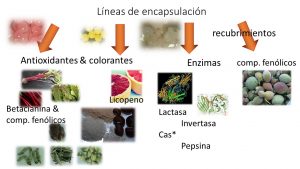Encapsulación y estudios de microestructura, estabilidad y liberación (GIEMEL)
Dr. Santagapita, Patricio Román - Investigador Independiente CONICET – Profesor adjunto (DE), FCEN, UBA
Dra. Aguirre Calvo, Tatiana Rocio – Becaria posdoctoral CONICET
Lic. Zazzali, Ignacio - becario doctoral CONICET – tesista FCEN-UBA – Profesor adjunto FCEN, UB (Universidad de Belgrano)
MSc. Gabilondo, Julieta - tesista FCEN-UBA – investigadora INTA (EEA-San Pedro)
Resumen
El grupo de trabajo cuenta con 3 grandes líneas de investigación, algunas consolidadas y otras en expansión.
1) Encapsulación de bioactivos obtenidos de residuos de la industria alimentaria (1a) y de enzimas de relevancia industrial (1b) en cápsulas de Ca(II)-alginato modificadas con azúcares e hidrocoloides; 2) encapsulación de compuestos fenólicos extraídos de residuos agroindustriales y la influencia del proceso de encapsulación y la microestructura. En este caso se exploran una variedad de métodos de encapsulación; 3) Extracción y caracterización de compuestos bioactivos obtenidos de residuos de la industria alimentaria y su inclusión en recubrimientos para alimentos IV gamma.
Actualmente, en uno de nuestro proyectos, el grupo busca consolidar la investigación en la comprensión de la estabilidad de distintas bioentidades en hidrogeles Ca(II)-alginato sometidos a diferentes procesos industriales (congelación, deshidratación y tratamientos térmicos) relevantes. Las bioentidades con las que trabajamos representan distintas escalas de los sistemas encapsulados relevantes en la Industria de Alimentos, desde pequeñas moléculas hasta microorganismos (compuestos fenólicos, colorantes, enzimas y microorganismos probióticos). Los hidrogeles de Ca(II)-alginato son sintetizados por gelificación ionotrópica y modificados con diferentes azúcares/biopolímeros, con el fin de aumentar la eficiencia de carga y al mismo tiempo proteger cada bioentidad en los diferentes procesos. Se buscará obtener información detallada sobre (1) el efecto de la formulación en la microestructura de los geles formados (a través de análisis DSC, FTIR, RMN y SAXS-entre otros-); (2) la influencia de las bioentidades encapsuladas dentro de la matriz de Ca(II)-alginato a nivel microestructural; (3) las propiedades de liberación en distintos medios, que emulen una posible matriz alimenticia de inserción de dichos sistemas y (4) la estabilidad/viabilidad y bioaccesibilidad de las bioentidades en condiciones de digestión- fermentación in vitro; (5) el impacto en las propiedades mecánicas y en la percepción de consumidores mediante análisis sensorial al ser incluidas en alimentos conocidos.
Abstract
Our research group has three main lines of research, some consolidated and others in current expansion.
1) Encapsulation of bioactives obtained from agro-industrial waste (1a) and industrially relevant enzymes (1b) in Ca(II)-alginate beads modified with sugars and hydrocolloids; 2) encapsulation of phenolic compounds extracted from agro-industrial waste and the influence of the encapsulation process and microstructure. In this case, a variety of encapsulation methods are explored; 3) Extraction and characterization of bioactive compounds obtained from food industry waste and their inclusion in IV gamma food coatings.
Currently, in one of our projects the group seeks to understand the stability of different bio-entities in Ca(II)-alginate hydrogels subjected to different relevant industrial processes (freezing, dehydration and heat treatments). The bio-entities represent different scales of the relevant encapsulated systems in the Food Industry, from small molecules to microorganisms: phenolic compounds, dyes, enzymes and probiotic microorganisms. Ca(II)-alginate hydrogels are synthesized by ionotropic gelling and modified with different sugars / biopolymers, in order to increase the encapsulation efficiency and at the same time protect each bio-entity in the different processes. We will seek to obtain detailed information on (1) the effect of the formulation on the microstructure of the gels formed (through DSC, FTIR, NMR and SAXS analysis -among others-); (2) the influence of the bio-entities encapsulated within the Ca(II)-alginate matrix at the microstructural level; (3) the release properties in different media that emulate a possible food matrix for insertion of those systems and (4) the stability / viability and bioaccessibility of the bio-entities under in vitro digestion-fermentation conditions; (5) the impact on the mechanical properties and the perception of consumers through sensory analysis when being included in known foods.
Publicaciones seleccionadas / Selected publications
“Fine-tuning of functional and structural properties of Ca(II)-alginate beads containing artichoke waste extracts.” Zazzali, I., Jaramillo, G., Gabilondo, J., Peixoto Mallmann L, Rodrigues E, Perullini, M., Santagapita, P.R. (2022). Food Hydrocolloids for Health, 2, 100097 (2022).
“Bioaccessibility assay, antioxidant activity and consumer-oriented sensory analysis of Beta vulgaris by-product encapsulated in Ca(II)-alginate beads for different foods.” Aguirre-Calvo TR, Sosa N., López T., Quintanilla-Carvajal MX, Perullini M, Santagapita PR. Food Chemistry Molecular Sciences, 5,100140 (2022).
A detailed microstructural and multiple responses analysis through blocking design to produce Ca(II)-alginate beads loaded with bioactive compounds extracted from by-products. T.R. Aguirre-Calvo, D. Aguirre-Calvo, M. Perullini, P.R. Santagapita. Food Hydrocolloids for Health, 1, 100030 (2021).
Influence of egg albumin and whey protein in the co-encapsulation of betalains and phenolic compounds from Bougainvillea glabra bracts in Ca(II)-alginate beads. F. Khun, P. Santagapita, C. Zapata Noreña. Journal of Food Processing and Preservation, 2021;00:e15918 (2021).
Evaluation of calcium alginate bead formation kinetics: an integrated analysis through light microscopy, rheology and microstructural SAXS. A. Posbeyikian, E. Tubert, A. Bacigalupe, M.M. Escobar, P.R. Santagapita, G. Amodeo, M. Perullini. Carbohydrate Polymers, 269, 118293 (2021).
Overall evaluation of artichoke leftovers: agricultural measurement and bioactive properties assessed after green and low-cost extraction methods. I. Zazzali, J. Gabilondo, L. Peixoto Mallmann, E. Rodrigues, M. Perullini, P.R. Santagapita. Food Bioscience, 41, 100963 (2021).
Effects of in vitro digestion–fermentation over global antioxidant response and short chain fatty acid production of beet waste extracts in Ca(II)–alginate beads. T.R. Aguirre-Calvo, S. Molino, M. Perullini, J.A Rufián-Henares, P.R. Santagapita. Food & Function, 11, 10645–10654 (2020).
Controlled release of fertilizers from Ca(II)-alginate matrix modified by yerba mate (Ilex paraguariensis) waste. L.M. Llive, M. Perullini, P.R. Santagapita, A. Schneider-Teixeira, L. Deladino. European Polymer Journal, 138, 109955 (2020).
Effect of in vitro digestion-fermentation of Ca(II)-alginate beads containing sugar and biopolymers over global antioxidant response and short chain fatty acids production. T.R. Aguirre-Calvo, S. Molino, M. Perullini, J.A Rufián-Henares, P.R. Santagapita. Food Chemistry, 333,127483 (2020).
High-intensity ultrasound-assisted extraction of phenolic compounds from cowpea pods and its encapsulation in hydrogels. Traffano-Schiffo, M.V., Aguirre Calvo, T.R., Avanza, M.V., Santagapita, P.R. Heliyon, 6(7),e04410 (2020).
